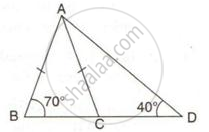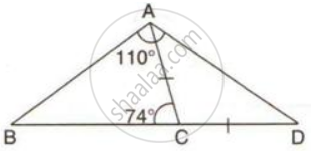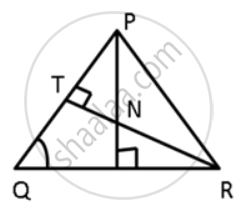Advertisements
Advertisements
Question
From the following figure, prove that: AB > CD.

Solution
In ΔABC,
AB = AC ...[ Given ]
∴ ∠ACB = ∠B ...[ angles opposite to equal sides are equal ]
∠B = 70° ...[ Given ]
⇒ ∠ACB = 70° ...(i)
Now,
∠ACB +∠ACD = 180°...[ BCD is a straight line]
⇒ 70° + ∠ACD = 180°
⇒ ∠ACD = 110° ...(ii)
In ΔACD,
∠CAD + ∠ACD + ∠D = 180°
⇒ ∠CAD + 110° + ∠D = 180° ...[ From (ii) ]
⇒ ∠CAD + ∠D = 70°
But ∠D = 40° ...[ Given ]
⇒ ∠CAD + 40°= 70°
⇒ ∠CAD = 30° …(iii)
In ΔACD,
∠ACD = 110° ...[ From (ii) ]
∠CAD = 30° ...[ From (iii) ]
∠D = 40° ...[ Given ]
∴ D > ∠CAD
⇒ AC > CD ....[Greater angle has greater side opposite to it]
Also,
AB = AC ...[ Given ]
Therefore, AB > CD.
APPEARS IN
RELATED QUESTIONS
In the given figure sides AB and AC of ΔABC are extended to points P and Q respectively. Also, ∠PBC < ∠QCB. Show that AC > AB.

In a triangle PQR; QR = PR and ∠P = 36o. Which is the largest side of the triangle?
If two sides of a triangle are 8 cm and 13 cm, then the length of the third side is between a cm and b cm. Find the values of a and b such that a is less than b.
D is a point in side BC of triangle ABC. If AD > AC, show that AB > AC.
In the following figure ; AC = CD; ∠BAD = 110o and ∠ACB = 74o.
Prove that: BC > CD.
"Caste inequalities are still prevalent in India." Examine the statement.
Name the greatest and the smallest sides in the following triangles:
ΔABC, ∠ = 56°, ∠B = 64° and ∠C = 60°.
For any quadrilateral, prove that its perimeter is greater than the sum of its diagonals.
ABCD is a quadrilateral in which the diagonals AC and BD intersect at O. Prove that AB + BC + CD + AD < 2(AC + BC).
In the given figure, ∠QPR = 50° and ∠PQR = 60°. Show that: SN < SR
